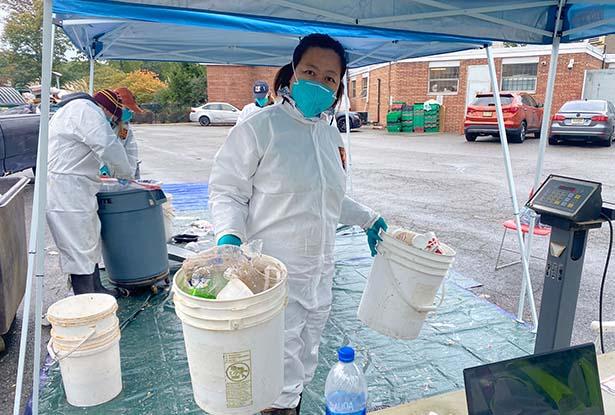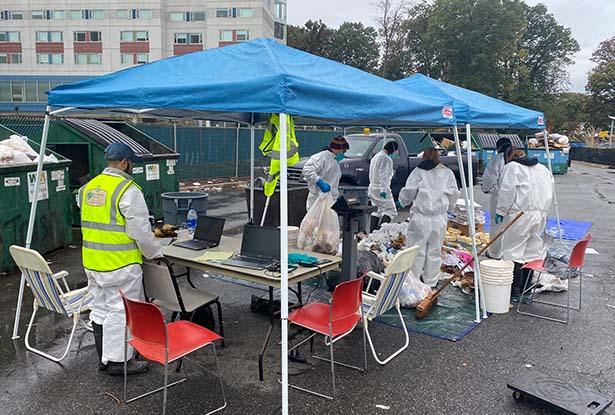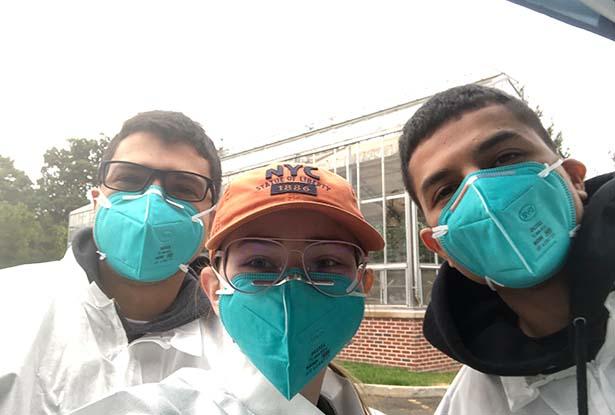Kean Researchers Seek Environmental Solutions in the Trash

Dongyan Mu, Ph.D., assistant professor in the School of Environmental and Sustainability Sciences, conducted a trash audit at the Union campus on October 23.
Kean University sustainability science researchers are investigating ways to send more of the University’s food and organic waste to the campus composter and reduce the amount of trash the University sends to landfills.
Assistant Professor Dongyan Mu, Ph.D., and Lecturer Will Heyniger in the School of Environmental and Sustainability Sciences received a New Jersey Department of Environmental Protection grant for their research to promote food waste composting and recycling at Kean. They are working with Kean students and collaborating with the New Jersey Composting Council on the one-year project.
“Kean University has already set the bar high on sustainability by being among the first universities in the state to install a campus composter,” said Kean President Lamont O. Repollet, Ed.D. “Everything we do to further our environmental protection efforts helps all of us, on and off campus.”
Kean’s campus composter has turned nearly 600,000 pounds of food waste into compost, a soil enhancement that provides nutrients for plants, since it began operations in February 2010. Mu said the composter is collecting and processing pre-consumer organic waste, the leftover scraps from food preparation. The goal of the current research is to promote the composting of post-consumer food waste, the food scraps we usually throw in the trash after eating a meal.
“We know that solid waste raises environmental concerns on land and in the ocean,” Mu said. “We want to promote campus sustainability, and focusing on food waste reduction is a good place to start.”

The initial phase of the project involved the first all-stream waste audit taken on campus. Mu, Heyniger and student volunteers geared up with protective suits, gloves, masks and goggles, and sorted through Kean’s trash dumpsters on October 23 to learn exactly what is being tossed out that can be composted or recycled.
Katelyn Bryant, a senior sustainability student from Springfield, was one of the student volunteers. She called the experience “very dirty and gross” but also enlightening.
“Although the experience was messy, I learned a lot,” she said. “One big thing I learned was that even if the bin is marked recycling only, people still put in other waste. That completely ruins the actual recyclable items. I think that is something important that people should know, especially if their goal is to help the planet.”

Mu said the audit determined that Kean’s waste generation is fairly typical – about 40% is organic compost material and 50% is recyclable. The next phase of the project will be a public education campaign to encourage composting and recycling, and the placement of trash cans specifically for food waste in the Miron Student Center cafeteria.
“With a resource as wonderful as the composter on campus, we want as much food waste as possible going into it in an effort to be a sustainable campus,” said Elise Dusenshine, a graduate student in architecture from Hamilton who is Mu’s graduate assistant. “By placing organic food waste bins around campus and explaining the project through posters, press and other outlets, we can begin to see a change in the waste disposal habits of everyone on campus.”
Two more trash audits will be conducted late in Spring 2022 to determine if the public awareness campaign was effective in increasing food waste collection for the campus composter.
“I really hope that more students will be involved in this project by the second and third audits, that they will see what is being dumped that can instead be recycled or composted, and they will change their actions for the future,” said Mu.
The project also will investigate optimal conditions for composting and test the compost Kean generates to determine its impact on growing fruits, vegetables and flowers.
Heyniger said, through the project, Kean can reaffirm its place at the forefront of the food scrap recovery movement.
“Kean can help solve complex issues by composting food, integrating it into soils everywhere we can, and then growing healthier, stronger, more disease- and drought-resistant food and flowers,” he said.